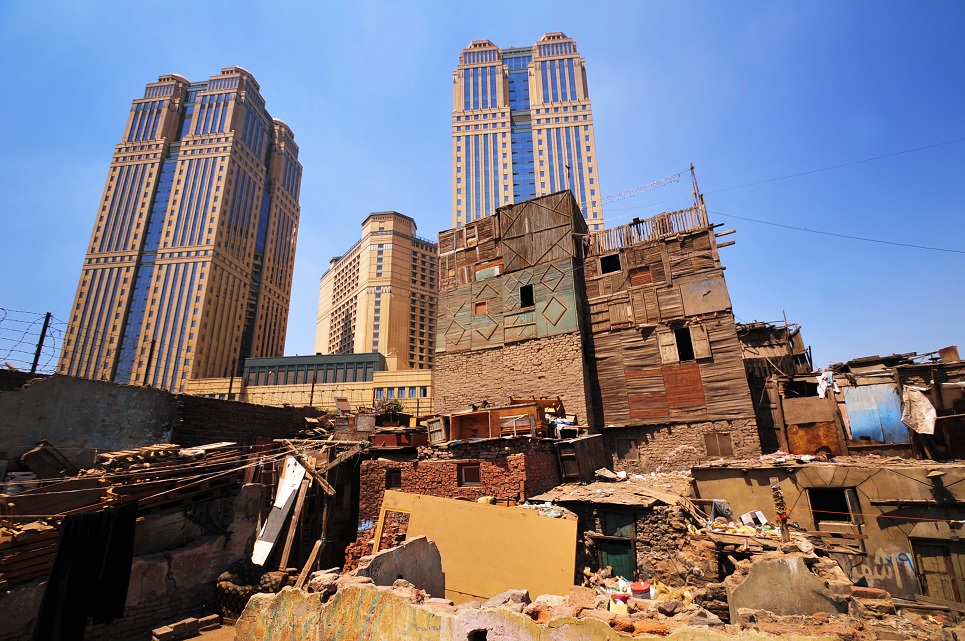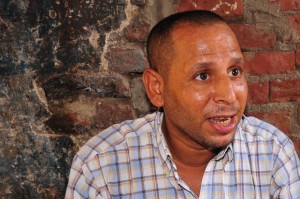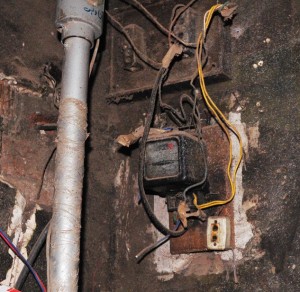
Hassan Ibrahim
To walk through the Kafrawy shacks in the Ramlet Boulaq area is to trek through unpaved roads and streets narrower than a doorway. There is no water or sewage and for every two wooden shacks there is one completely levelled to the ground by the former inhabitant, who was forced to sell it for a thousand times less than its real value.
Only a few metres away, the impressive Nile City Towers stand tall with sleek blue glass and comforting signs of modernity. The contrast is daunting; it is class inequality epitomised.
“Our conditions were much better before the towers went up than they are now. At least back then we could make a living,” says Mohamed Saleh, a Ramlet Boulaq resident. Saleh remembers when the area was home to iron warehouses, workshops and barbershops, all of which provided employment. That was over 15 years ago.
Land rights, coercion, and history
The three towers, situated on the banks of the Nile, are home to an exclusive shopping mall, eight movie theatres, an assortment of restaurants and cafes as well as office buildings for very high profile companies such as AIG, EGF Hermes, Intel, Mobinil, Orascom Telecom, and Procter and Gamble. The third tower houses the luxurious 25-storey Fairmont Hotel.
The complex is a joint venture between the Saudi Arabian Shobokshi family and the Egyptian Sawiris family, led by telecommunications tycoon Naguib Sawiris. Nile City Investments started acquiring land in 1995 and the towers went up two years later.
“Sawiris bought this land from the Kafrawis and started building the towers. The sand and mud from the construction made us blind and killed our children; we had to rush the ones with allergies to hospitals and emergency rooms. They made our lives hell and sometimes we would go over there and prevent construction,” said Saleh.
He added that after the towers were built, some of the shack residents were hired to work in them and Sawiris started trying to buy the rest of the land surrounding the towers, including their shacks, first through normal agreements and deals, but eventually by force.
The land on which the shacks are built is part of the original plan for the tower complex. It is set aside for a car park and garden among other uses. Because of its prime location, the price of one square metre in Ramlet Boulaq is high, estimated in an Egyptian Centre for Economic and Social Rights report to be around EGP 36,000.
“They [Nile City Towers management] used to offer us EGP 5,000 per square metre, now they are only offering EGP 1,500 and you have to sell whether you like it or not. We had the governorate determine the value of a square metre and we know it costs EGP 36,000,” says Saleh.
On 20 July, the Cairo Governorate issued a temporary seizure order. According to Saleh, the government has not provided them with concrete answers as to where it would relocate them if they moved.

Hassan Ibrahim
“This is our land, and Nile City Investments wants to buy it. It is between them and us. It is not the government’s right to interfere,” says Maher Ahmed, a former resident.
Malek Adly, a lawyer with ECESR handling the Ramlet Boulaq case, told the Daily News Egypt that there are three types of decisions the government can make to take away land: confiscation, temporary seizure, and eviction.
According to Adly, confiscation, which is permanent, requires the government to pay a large compensation fee to the owners. The government has to go through a long and convoluted legal process to take the land.
What actually happens is that the government issues temporary seizure decisions, gives the owners a measly compensation and demolishes the buildings, which is illegal while temporarily seizing land. Three years later, when the temporary seizure is finished, it issues a permanent confiscation decision. That way, the government avoids paying real compensation and going through legal procedures.
“The government disobeys the law and acts like a business, which is unacceptable. That is what is happening in Ramlet Boulaq. The government will keep the land for three years, demolish the buildings, then confiscate it and sell it to Nile City Towers” said Adly.
Adly said ECESR filed a case with the Administrative Judiciary Court against the Cairo governor’s decision and asked for it to halt until the case is reviewed. A court date has not been set yet.
Temporary seizure decisions can only happen in cases of extreme emergency like natural disaster or war. The 20 July decision fulfilled neither criterion and is considered forced migration and as such violates international human rights treaties.
The shack residents are also frequently accused of being squatters and having no legal right to the land.
“Some of us even have ownership deeds. All of us have this place written as our address on our national ID cards. And besides, even if we were squatters, the law says that if someone stays long enough on a certain piece of land, 15 or 25 years, they get ownership of it. We have been here for 100 [years],” he said.
Adly confirms this. According to Egyptian housing laws, if a citizen or group of citizens continue to inhabit a piece of land for over 15 years without dispute, they legally become its owners.
The Ramlet Boulaq community’s elders explained to the Daily News Egypt that they have been in the area for a very long time.
One woman, Attiyat Kotb sat on her bed in a small shack eating. The men swore she is 120 years old and was born in Ramlet Boulaq. Another woman, Um Sayed, is 95 years old. She said she was also born there and produced her national ID as proof of her age. It checked out.
“This land was originally owned by two feudal lords, Azawy and Kafrawy, hence the name. Both pashas were from Upper Egypt and would bring labourers to work on their lands. At the time it was normal to allow their workers to build homes and kiosks on the land. This was over 100 years ago,” said Adly.
After the original owners die, ownership of the land transfers to the labourers and their progeny after 15 years have passed, although there are people claiming to be Kafrawy’s heirs who collect rent from some shacks. There is currently a legal dispute between the alleged Kafrawy heirs and the shack inhabitants. According to Adly, there have been court rulings that granted the residents ownership rights over the land.
According to Ahmed, the entire buying process is unfair since there is no unified price. The company might buy at a price of EGP 5,000 per square metre from one resident, then EGP 1,000 from another.
“About ten years ago, the company even got many shack owners to sell their houses for EGP 300 per square metre and the people did not know any better so they did it,” he said.
Lack of services and poor conditions
The residents are eager to show off the electricity metres in their shack. They say they’re proof that the state recognised the area as more than just a slum. Electricity is the only available service, however.
There are no sources of clean drinking water in Ramlet Boulaq. The shack residents possess two sinks into which they connect two hoses, with several loose ends running to different shacks.
“We never had any water to begin with. No one even knew who we were before the towers were built,” said Ahmed in response to the question of whether or not water had been cut as a pressure tool.
As for sanitation, the residents of the Kafrawy shacks do not have proper toilets, only incredibly small rooms with a hole in the ground. Each toilet is on average shared by three families with between two and ten children each.
“Our women have to wait until the dead of the night before attempting to go to the bathroom,” said Saleh. “It is unbearable.”
The death of Amr El-Bunni
Large cracks in the glass entrance of the tower nearest the shack are a lingering reminder of the events of 2 August that triggered the latest police and media campaign against the residents of Ramlet Boulaq.
That day, Amr Fathy, known in the area as Amr El-Bunni, went into the Fairmont Hotel alive and came out dead.
El-Bunni had a disagreement with a tourism police officer inside the building. The officer shot him, once in the leg and again in the back. He died immediately.
The Ministry of Interior initially released a Facebook statement saying El-Bunni was shot in the back before promptly deleting it and releasing another, with El-Bunni being shot in the stomach. The officer’s action was justified and it was claimed that the officer acted in self-defence.
One Ramlet Boulaq resident who chose to remain anonymous was able to provide the Daily News Egypt with a video taken on his camera phone of the last few minutes before El-Bunni’s body was moved. The bullet wound created a hole both in his stomach and back, but his shirt was completely clean from the front with no bloodstains whatsoever, meaning El-Bunni was shot in the back.
Another resident, Anwar Abdel-Latif, went to investigate when he heard El-Bunni had been shot. His young son Hamad accompanied him. When he arrived on the scene, Abdel-Latif was also shot, this time in the thigh. As Hamad tried to help him, the young boy was also shot in the leg.
Hamad, thin and very quiet, now walks on two crutches. He did not speak at all, just stared.
“Look at him,” one resident said. “He’s just a boy, only 15 or 16. Does he look like a thug to you?”
Upon hearing of the shootings, several young men from the shacks rushed to the towers and destroyed the glass doors at the front of the building. The interior and emergency doors to the towers were sealed off until Central Security Forces arrived to disperse the crowd.
Before the riot police made it to the scene however, approximately twenty cars and fifteen motorcycles were burned in the Nile City Towers’ parking lot.
“We attacked the hotel with stones and broke its glass. I won’t lie, but this was after the government [police] shot about four or five of our people. We even know the officers’ names,” said Saleh. “Yes we set fire to cars, but they killed a person. There is nothing more important than a life. If you saw your friend shot, what would you do? You would lose your mind.”
The tourism police officer responsible for the shooting was not detained. He was instead honoured by the Minister of Interior the next day and given a financial reward.
Adly says the ECESR filed a case against several police officers but it has not yet been examined.
El-Bunni: Collecting monthly wages or extorting protection money?
According to statements released by both the Ministry of Interior and the Fairmont Hotel shortly after the clashes, El-Bunni had come to the hotel to collect protection money he and some “thugs from Ramlet Boulaq” had been forcing the management to pay. When the officer would not allow him in, El-Bunni pulled out a knife and the officer shot in self-defence.
The Ramlet Boulaq residents all deny this narrative. According to more than one source, Nile City had actually informally hired many of the shack’s residents to protect the tower during and after the 25 January 2011 uprising after the police force all but collapsed.
“He [Sawiris] actually used to pay a lot, between EGP 250,000 and 300,000 per month. He hired about 300 people from here. Most people got EGP 400 but some got much more,” said a shack resident who chose to remain anonymous.
Amr El-Daly was Nile City Towers’ head of security until last February. El-Daly confirms that he had indeed hired the people of Ramlet Boulaq to protect the towers in the absence of security and that senior management was fully aware of the situation.
“They used to come collect their money at the beginning of the month. They didn’t have contracts, obviously, but there was a register and all their names and wages were in it,” he said.
Nile City Towers hired about 300 residents of Ramlet Boulaq, but not all of them for the purpose of protecting the towers. Many of the residents were hired to keep an eye on the levelled shacks and make sure no one re-inhabits them.
So what happened that day? What prompted El-Bunni to go to the tower asking for his wages? Why did he not just collect them like everyone else?
According to the current Deputy Head of Security at Nile City Towers, Ramadan Mohamed, the wages were all ready on 2 August except for those of five people whom the management decided would not get paid. El-Bunni was one of them.
Mohamed said the management had wanted to get rid of the residents for a while and as such was looking to create problems. He confirmed that the residents of Ramlet Boulaq were getting paid to secure the towers without collecting protection money.
“We used to get blankets and sleep on the street to protect these towers. We faced death and other dangers, men from Giza would come and attempt to rob the place and we would stop them and give them to the government [police] and this is the thanks we get?” asked Saleh.
“I knew that as soon as the police were back, they would get rid of us. Do you know why? Because we are poor and that’s how poor people are treated in this country,” Ahmed said solemnly.
Police retaliation and constant state of fear
The 2 August clashes finally ended at midnight that day. Or so the people of Ramlet Boulaq thought. At around 4 am, just after the Fajr (dawn) prayers, police forces stormed the Kafrawy shacks area, kicking doors open and arresting as many males as possible.
“They kicked down the doors and went inside our homes. They saw our women in their night clothes,” Saleh recounted.
The residents described how the soldiers searched their homes, grabbing any money they could find. They were more than happy to show the Daily News Egypt their broken cupboards and beds.
“They wouldn’t let me get dressed; they took me in my underwear at dawn. They chose the quiet time when nobody would be expecting anything. There were three or four officers leading many soldiers with Central Security Forces tanks. They were like the Tatars; they took everyone and each man they took would be hit by every single soldier on their way back,” said one youth.
“My mother is an old woman. What if she had suffered a heart attack due to one of these soldiers kicking her door down at 4 am? What if she had died? Who would have we held accountable then?” asked Ahmed.
The community right now is living in a constant state of fear. According to Adly, 23 people have been arrested so far on charges of attacking security officials, attacking private properties, blocking the road, and burning vehicles. They were detained for four days, then the court renewed their detention for another 15.
Even though cars were burned, Adly says, the police need proof that these individuals set fire to them, including the time of the act and the instrument used. The police have no such evidence, he says, so these men’s detention is therefore unfounded.
“Legally speaking, these arrests are random, the charges are trumped up, and the medical reports forged,” said Adly.
Several of those detained have been horribly beaten and some of the men arrested are not even from Ramlet Boulaq. They were randomly arrested for being in the wrong place at the wrong time, he added.
“The youth in front of you now are the only remaining ones in the area. Everyone else is in prison or has fled,” Saleh said as he motioned toward three young men. “When the government [police] shows up, we all disappear.”
The fallout
The people of Ramlet Boulaq are convinced that Naguib Sawiris is behind all of their misfortune and they believe his motivation is pure greed.
“He would much rather have the land for free. As we say, the millionaire always wants to be a billionaire. And how do you think he will make the difference? From the blood of the poor of course,” Ahmed said.
“The order comes from Sawiris to the police station. He tells them he doesn’t want a single man in the area. When the police now see a man here they curse us and tell us to leave because they want only women in the neighbourhood. If all the men are imprisoned the women would have to sell the land in order to get them out,” said Saleh.
He is very resentful of the media coverage identifying the residents as thugs.

Hassan Ibrahim
“The media says we have weapons. If we have weapons how come there is no photographic proof of this? If we have weapons how come we didn’t use them to defend ourselves?” he said. “We are not thugs; we are workers and students, and we are good people.”
“There is a war between us and this building,” says Ahmed as he points towards the tower. “This is our greatest enemy, even more than the government. The government is just a tool that beats us on behalf of the tower,” he adds.
“What they are doing is turning the people of Ramlet Boulaq into real thugs, but if this happens, then they will see. I will only leave here dead.”

